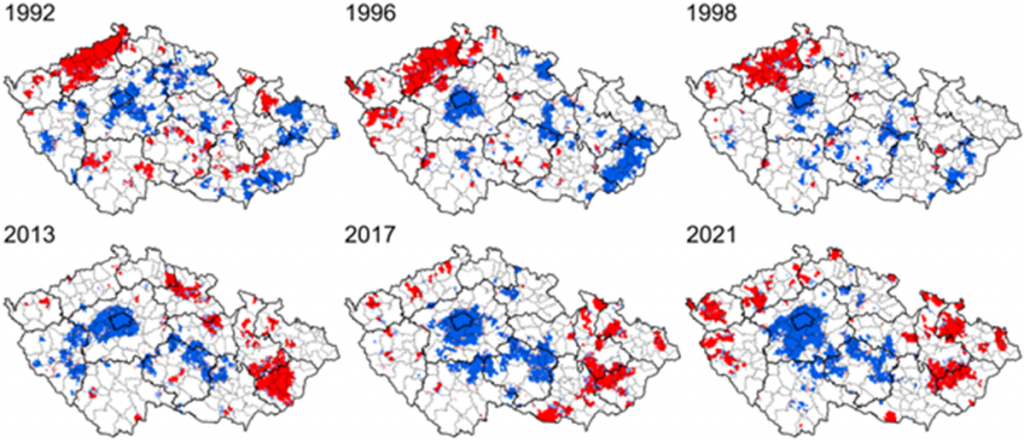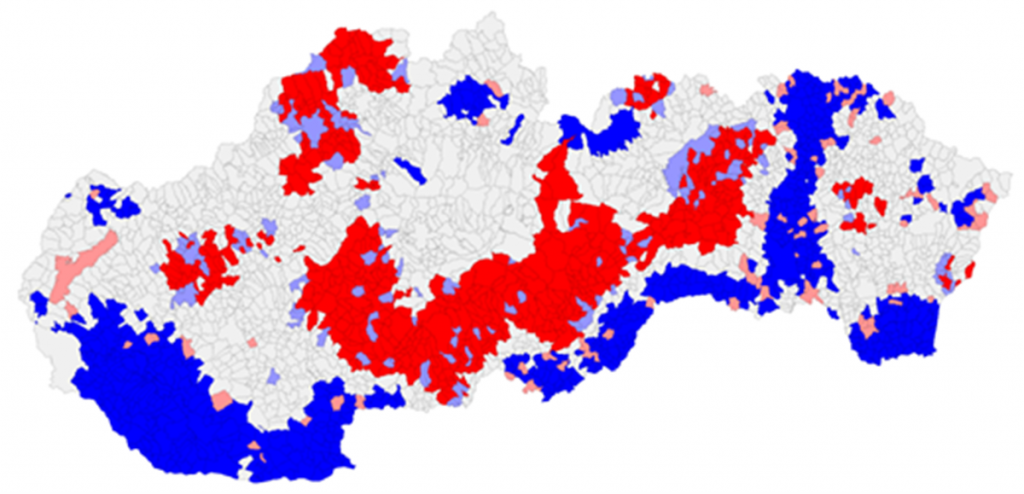At the 2023 ECPR General Conference in Prague, Dominik Kevický and Jonáš Suchánek noticed hundreds of political scientists questioning the 'whys', 'whos', and 'hows' of the populist radical right. Here, they offer a spatial perspective on populist radical-right voting, arguing that we shouldn't overlook the 'wheres'
From a geographical perspective, one way to investigate the spatial aspects of elections is by examining the 'left-behind places'. In recent years, this approach has gained substantial traction in the fields of geography, sociology, and political science. Left-behind places typically experience long-term socioeconomic decline, demographic stagnation, and high inequality. The people who live in them experience discontent and resentment inherently linked to these particular places and spaces.
Consequently, many voters in such areas feel betrayed by the core cities. There, citizens prosper from successful economic transitions and demographic shifts associated with globalised processes. The peripheral regions, meanwhile, are left out or lag behind. The political reaction of people and places to this perceived abandonment is pivotal. We see its effects in the election of Donald Trump, Brexit, and in the rise of radical-right and populist parties across Europe.
Voters in left-behind places feel betrayed by city-dwellers, who reap the benefits of globalisation
To illustrate the intricate interplay between left-behind places and radical-right voting, our research turns to two central European countries: Czechia and Slovakia. In both countries, the rise of radical populist and nativist parties has been significant, especially since the 2015/2016 refugee 'crisis'.
First, let's take a look at the spatiotemporal distribution of electoral support for the most prominent populist and radical-right parties in Czechia since the 1990s. See the graphic below. The so-called Republicans (SPR-RSČ, 1992; 1996; 1998) had similar ideological stances (mostly nativist and Eurosceptic) as the Czech SPD (2017; 2021). Despite this, the spatial patterns of their votes are vastly different. As our analysis suggests, there were significant and systematic clusters of high electoral support (red) for the Republicans in North-West areas. Low support (blue), meanwhile, clustered in and near the capital Prague and other regions.
All the populist radical-right parties found success in places that we could classify, to varying degrees, as being 'left behind'
Blue clusters in Prague and central Bohemia remain relevant for SPD, too. Yet the high support for this contemporary radical-right party in Czechia was driven mainly by voters in other places, such as locations in Moravia and other peripheral areas of Western Bohemia. On the contrary, the Dawn (2013) party placed much more emphasis on populist stances. It gained substantial support in areas from which neither the Republicans nor the SPD profited.
All these populist radical-right parties found success in places that we could classify, to varying degrees, as being 'left behind'. But in this case, patterns are anything but stable. Different parties attract different support at different times.

In Slovakia, we find a similar distribution of the populist radical right as in Czechia. We demonstrate this through analysis of electoral support for the People's Party ‘Our Slovakia’ in the parliamentary elections. Below, we offer more specific insight into the underlying reasons behind these patterns.
In the 2010 and 2012 elections, the People's Party 'Our Slovakia' enjoyed strong support in municipalities with a larger Roma minority population. The party then shifted focus to criticise the government's regional development policy, the functioning of EU subsidies, and the globalised economy. Its popularity subsequently increased in left-behind areas. As a result, the party gained more traction in regions with a lower proportion of tertiary-educated individuals, higher unemployment rates, a greater number of distrains, and other relevant socioeconomic factors.
As the map below shows, a unique aspect of the Slovak situation is that the populist radical right finds less success in regions with a higher proportion of people of Hungarian nationality (blue).

The populist radical right in Czechia and Slovakia enjoys success in places we could categorise as 'left behind'. However, one question remains: Are these places themselves the reason people choose the populist radical right?
The answer is both no and yes.
We conducted interviews with several residents of left-behind places in Czechia and Slovakia. Subjects revealed that a number of emotions, including fear, grievance, and nostalgia, played a crucial role in influencing their political choices.
When people in left-behind places vote for the populist radical right, they see it as a potential solution to their existential challenges
Such emotions are triggered in particular among voters in left-behind places with high grievance levels. These people fear the situation in their region may deteriorate further, and they feel nostalgic for a time when their region was more affluent. So when people in left-behind places vote for the populist radical right, they see it as a potential solution to their existential challenges.
This brings us back to our initial point. The question of 'where' is essential in understanding the growing popularity of the populist radical right. This is true not only in Czechia and Slovakia, but most likely everywhere.
No.63 in a Loop thread on the Future of Populism. Look out for the 🔮 to read more